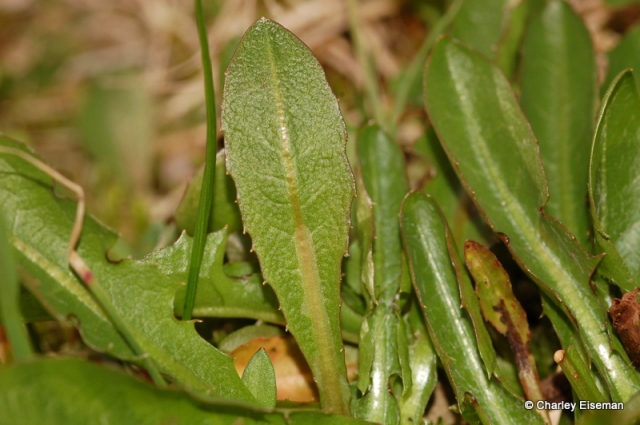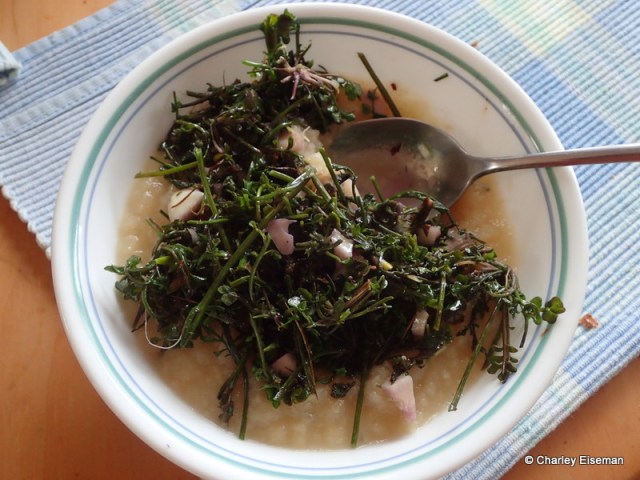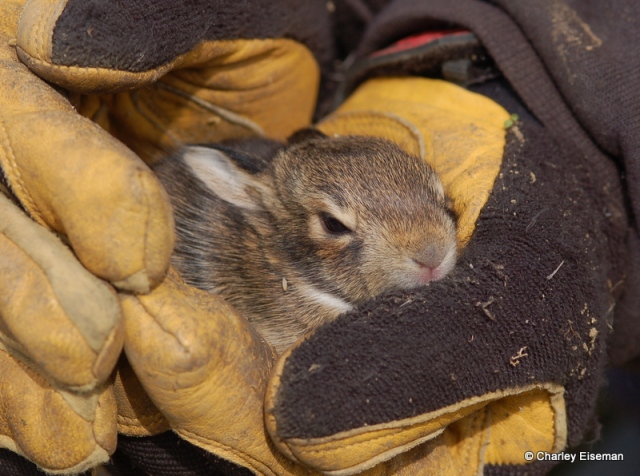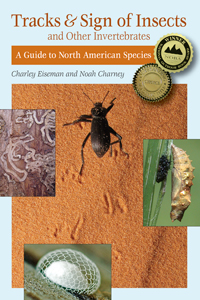Yesterday afternoon I spotted the sixth leafminer species of the season for my yard list. The mine was a subtle one, which I probably wouldn’t have noticed if I hadn’t been lying face-down in my lawn and nibbling dandelion greens.

See it? This sneaky species forms a clean, whitish mine right over the midribs of dandelion leaves. Here’s a closer view:

I first noticed this type of mine in a small, isolated plant growing along my driveway on April 21, 2016. Rather than picking the leaf right away, I watched the mine develop over a couple of weeks. When I first spotted it, the plant was just beginning to grow its second leaf:

By May 5, that second leaf was larger than the original one, and the larva had abandoned the first leaf (at right in the photo below) in favor of the new one (at left).

On further investigation, I discovered that the larva had also abandoned the second leaf, mining into the underside of the plant’s third leaf, where it had just formed a puparium right next to the midrib.

Mind you, this larva was not capable of exiting the plant and then reentering; each transition to a new leaf was accomplished by mining down one petiole to the base and then entering the base of another petiole. Given how early in the season this species shows up, I suspect that eggs may be laid in the fall, with young larvae overwintering in the crowns of the plants. I’ve documented something similar in the related fly Ophiomyia congregata (Agromyzidae) on the related plant Nabalus (formerly Prenanthes; common names include white lettuce and rattlesnake-root). This dandelion miner is O. nasuta—here’s the adult that emerged from the mine along my driveway, on May 20 or 21:

On larger-leaved dandelion plants, there may be no upper-surface portion to the mine at all, as in this example I found in my yard on April 24, 2017. It’s essentially invisible except for the puparium itself. This is another one I only found because I was munching on dandelion greens.

Since my last post I’ve also added four more species to the list of plants I’ve eaten from my yard this spring:
22. Early winter cress (Brassicaceae: Barbarea verna) – leaves
23. Garlic (Amaryllidaceae: Allium sativum) – leaves
24. Parsnip (Apiaceae: Pastinaca sativa) – roots
25. Hairy bittercress (Brassicaceae: Cardamine hirsuta) – leaves
I hadn’t really tried (or really identified) hairy bittercress before, but it occurred to me while weeding it out of a strawberry patch that it might be worth eating. I found this page about it and agree with the assessment that it would be more accurate to call this plant “Not-so-hairy and pleasantly-mild spicycress.” After sautéing a big pile of it, it made a great addition to some parsnip soup.

Nevertheless, Julia and I thought it would be nice to have more than just weeds to eat later in the season, so yesterday we finished rabbit-proofing the fences around our vegetable gardens. And not a moment too soon, it turned out, as we found this baby bunny inside the garden where we’ll soon be planting beans:








I’m guessing rabbit stew is not in your future? Love the image of you grazing along on your belly!
Not ruling it out entirely, but for now we’re leaving them to the foxes and bobcats!
Interesting how we are ‘trained’? to feel warm & fuzzy with a little rabbit (ah……..) but not with the dandelion miner!
Fun read–I, too, can see you lying around nibbling. Love the little bunny pics. : )
Re: O. nasuta — So, does it taste good?
Too small and infrequent to say!
I look forward to the next sunny day where I can crawl around on my belly looking for this miner. Good lead on the bitter cress too. I’d always nibbled it raw, never as a green to saute.